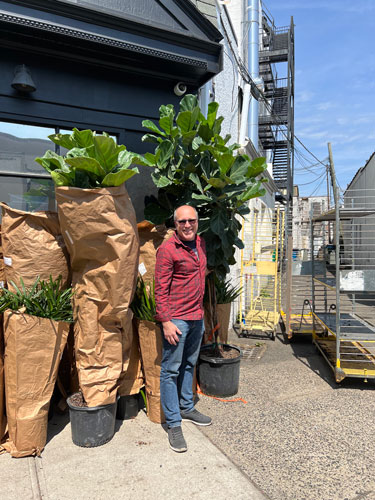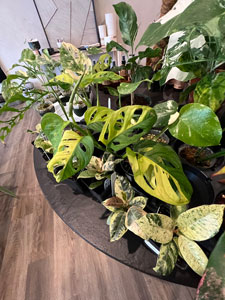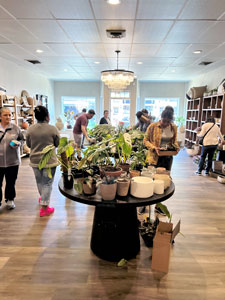5/1/2024
Setting Up a Houseplant Pop-up Shop
David Williams

After closing Williams Nursery (in Westfield, New Jersey) in 2022, I found myself missing certain aspects of retail. I’d cultivated a significant following among our indoor plant customers on Instagram, especially during the pandemic when I expanded our tropical plant department from $50,000 to $500,000 annually.
As a passionate plant geek, I focused on keeping our product mix trendy, often featuring a variety of rare and unusual plants. While I was contemplating life after the garden center, a store owner from my town had contacted me to see if I would be interested in doing a plant pop up in her store. I visited her store to check on the vibes. It was a home décor/lifestyle that was on trend and high end. I thought it would be a good fit.
Pictured: David Williams stands with a shipment of plants before the pop-up shop at a high-end home décor retailer in New Jersey.
The transition from managing a garden center to curating a pop-up event within another business’ space posed a unique set of challenges, from logistical constraints to the meticulous selection and presentation of the plant inventory. The absence of truck and staff necessitated a creative approach to the entire event.
Choose Suppliers Wisely
Central to the success of this pop-up shop was the collaboration with suppliers that I had while I ran my garden center—Foliera, based in Canada, and Emma’s Garden, located in New York. These partnerships were instrumental in overcoming logistical hurdles, and ensuring a diverse and appealing selection of plants.
 Foliera’s commitment to accommodating small-scale orders and their service of pre-pricing plants significantly streamlined the preparation process. In contrast, Emma’s Garden offered the invaluable opportunity to handpick unique and unusual plants, catering to the discerning tastes of our anticipated clientele. Both could deliver directly to the pop-up store location. I drove to Emma’s to hand select the unusual plants for the pop up.
Foliera’s commitment to accommodating small-scale orders and their service of pre-pricing plants significantly streamlined the preparation process. In contrast, Emma’s Garden offered the invaluable opportunity to handpick unique and unusual plants, catering to the discerning tastes of our anticipated clientele. Both could deliver directly to the pop-up store location. I drove to Emma’s to hand select the unusual plants for the pop up.
My margin for the pop up was lower than typical garden center prices to incentivize purchases at the event. While aiming to sell out was ambitious, I anticipated about a 20% surplus, which I planned to donate to our local master gardener program, factoring this into the pricing. The event exceeded expectations, with less than 10% remaining unsold.
Pictured: The houseplants were sourced from two vendors—Foliera in Canada and Emma’s Gardens in New York.
A crucial strategy for the pop up involved employing ChatGPT to simplify managing plant information and pricing. By transforming supplier invoices into organized tables, I could swiftly produce labels and care sheets, detailing each plant’s name, light and water requirements, and a key fact. This process improved the customer experience by minimizing the manual labor typically required for such tasks. It helped, since I enlisted a few people to help with the event, but they didn’t have a lot of plant knowledge.
Bringing in the Business
I started promoting the pop up on my former business’ Instagram page months in advance. The excitement was evident from the start, with the first post garnering 544 likes and 55 shares. At the time of closing, my business had nearly 8,000 followers. The host store was also posting to her followers.
I aimed to feature a trending plant to spark interest and boost revenue, choosing the 3-in. Monstera Thai Constellation. Sourcing 20 from Rare Plant Fairy, a wholesale mail-order company, I purchased each at $50 and sold them for $99—a competitive price in 2023. I took pre-orders before the event, selling them using Square. Presales helped add interest with my marketing. During the event, every plant sold, leaving a few attendees wishing they’d managed to get one. Additionally, I collaborated with the host store to promote sales of handmade pottery, providing sizes and quantities for order placement. Supporting the host store’s sales was a priority, ensuring mutual benefit from the event.
The three-day pop-up event successfully generated about $10,000 in sales. This accomplishment underscored the event’s success and the community’s strong interest in unique houseplants. It also provided me with a fun way to see some of my old customers.
Lessons Learned
For a garden center to run a successful houseplant pop-up shop, I’ve put together some key strategies:
• Leverage existing strengths: Begin by identifying your garden center’s unique offerings or best-selling items, much like our tropical plant department’s success. This focus not only differentiates your pop up, but also capitalizes on already popular trends among your customer base.
• Choose the right partner: The collaboration with a complementary host business is critical. Look for businesses that share a similar clientele, but don’t directly compete with your offerings. Lifestyle stores, breweries, cafes or local artisan shops can be ideal partners, offering a new audience and a shared customer experience that benefits both entities.
Pictured: The three-day pop-up shop garnered $10,000 in sales with a unique selection of houseplants.
 • Logistics and inventory management: Address the logistical challenges head-on. If transportation and staffing are concerns, consider leveraging local networks or hiring temporary help for the event’s duration. For inventory, work with suppliers like Foliera and Emma’s Garden, who can provide a range of plants that cater to both common preferences and niche interests. Support in pre-pricing and allowing for a hands-on selection process can significantly ease the operational burden.
• Logistics and inventory management: Address the logistical challenges head-on. If transportation and staffing are concerns, consider leveraging local networks or hiring temporary help for the event’s duration. For inventory, work with suppliers like Foliera and Emma’s Garden, who can provide a range of plants that cater to both common preferences and niche interests. Support in pre-pricing and allowing for a hands-on selection process can significantly ease the operational burden.
• Marketing and engagement: Utilize social media platforms to create buzz around the event. Highlighting exclusive or rare plants, like the Monstera Thai Constellation, can attract enthusiasts and drive foot traffic. Engage with your audience through teasers, behind-the-scenes looks and interactive content to build anticipation. For me, Instagram was the most effective for my houseplant sales.
• Presentation and experience: The physical setup of your pop up should invite curiosity and exploration. Using visually appealing display options, such as wooden crates or unique pottery, can enhance the overall aesthetic and encourage purchases. The goal is to recreate the sense of discovery and wonder that customers feel in your garden center, within a new and exciting environment.
• Financial considerations: To ensure the event is financially viable, carefully calculate pricing strategies that offer value to customers while covering your costs and desired margins. Consider special promotions or bundled deals for the pop-up shop duration to incentivize purchases.
For garden center owners looking to expand their reach and experiment with new retail concepts, a plant pop up offers a unique opportunity to engage with customers in a novel setting. It allows for the showcase of your expertise and offerings in a manner that’s both educational and experiential. You can craft an event that resonates with plant lovers and contributes to your business’ growth narrative. GP
David Williams, a fourth-generation garden center owner and former president of the Garden Centers of America (GCA), has recently embarked on a new venture as a partner at Garden Center Consultants, leveraging his extensive industry expertise to shape the future of garden retail. Contact him at dave@gardencenterconsultants.com.